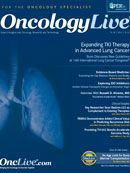Publication
Article
Oncology Live®
No Age Limit for Bone Marrow Transplantation
Author(s):
Age is no longer a consideration when determining whether an older patient with blood cancer is a candidate for stem cell transplantation.
Rainer Storb, MD
Member, Clinical Research Division
Fred Hutchinson Cancer Research Center
Seattle Cancer Care Alliance
Age is no longer a consideration when determining whether an older patient with blood cancer is a candidate for stem cell transplantation. That was the conclusion two years ago of the first study summarizing long-term outcomes from a series of prospective clinical trials of patients age 60 or older treated with nonmyeloablative transplants, known as mini-transplants, developed at Fred Hutchinson Cancer Research Center. The findings were published November 2, 2011, in the Journal of the American Medical Association.1
On April 20, 2013, the Journal of Clinical Oncology published results with more definitive data from nearly 1100 patients that showed comorbidities contribute significantly to poorer transplant outcomes.2 The study involved patients who were enrolled in prospective multicenter clinical trials between 1997 and 2009. All were age 60 or older; all were treated with the same nonmyeloablative regimen, developed at Fred Hutch; and all had acute or chronic leukemia, lymphoma, multiple myeloma, myelodysplastic syndromes (which can progress to acute myeloid leukemia if not treated), or myeloproliferative diseases, such as chronic myelogenous leukemia.
Both comorbidities and a higher degree of cancer aggressiveness affected survival among these older patients. For example, patients who had fewer comorbidities and less aggressive cancer had a fiveyear survival rate of 60%, while patients with more comorbidities and more aggressive cancer had a survival rate of 30%, regardless of age.
Although survival rates of 30% to 60% may seem low, these patients all would have died of their diseases within a matter of months without a transplant. The majority of patients were referred for a transplant after they had exhausted all forms of conventional therapy.
Conventional Versus Nonmyeloablative Transplants
While there is much room for improvement, particularly with regard to relapse, these results are encouraging given the poor outcomes with nontransplant treatments, especially for patients with high-risk acute myeloid leukemia, fludarabine-refractory chronic lymphocytic leukemia, or progressive lymphoma.
Nonmyeloablative transplantation was developed by researchers at Fred Hutch specifically for older and sicker patients who could not tolerate the more toxic, highdose regimens used to prepare patients for conventional transplantation.
Conventional transplants, which are generally not performed for people who are over age 60 or are medically unfit, require high doses of total body irradiation and potent chemotherapy to eliminate cancer cells. This intense treatment destroys the patient’s blood and immune system and is fatal unless the patient is rescued by an infusion of bone marrow or stem cells from a donor.
Nonmyeloablative transplants, in contrast, rely on the ability of donor immune cells to target and destroy the patient’s cancer without the need for such high doses of radiation and chemotherapy. Instead, moderate-dose radiation and chemotherapy are used to suppress, but not destroy, the patient’s immune system. This helps the body accept the donor cells, which then go to work attacking the patient’s cancer—called the graft-versus-tumor effect—and rebuilding the patient’s immune system.
Relapse Rates
In addition to survival and the impact of comorbid conditions, the 2013 study examined rates of relapse, hospitalization, acute and chronic graftversus- host disease (GVHD), and the toxicity of the treatment to internal organs. In one key finding, disease-relapse risks, not increasing age, were associated with worse outcomes. Other data showed that two-thirds of the surviving older patients who were affected by chronic GVHD had complete resolution of their symptoms and were able to discontinue immunosuppressive medications after a median time of two-and-a-half years from diagnosis. This was comparable to the results reported by previous studies on younger patients who were treated with high-dose radiation and chemotherapy. Half of the older patients never required hospitalization after transplant.
These findings, together with the normal to near-normal performance status of surviving patients, should help allay reluctance to enter older patients with hematologic cancers on nonmyeloablative transplant protocols. Additionally, the lack of matched sibling donors is no longer a limitation, given that transplants with matched unrelated donors have comparable outcomes.
Looking Forward
Fred Hutch investigators continue to explore novel variations on the nonmyeloablative—transplant theme to reduce relapse rates, particularly among patients with more aggressive blood cancers. New prospective clinical trials, with a focus on better GVHD prevention, are nearly under way. The goal is to eliminate toxic systemic conditioning.
One exciting trial is investigating whether the systemic chemotherapy and total body irradiation used in current transplant conditioning regimens can be replaced with an antibody against blood cells that has been coupled with a short-lived, alpha-emitting radionuclide. The alpha emitter is much more powerful than the beta-emitting radionuclides introduced in the 1980s. The targeted radiation possible with this radiolabeled antibody would greatly reduce the toxicities associated with current conditioning regimens.
The alpha-emitting radionuclide is an isotope called astatine-211. It is between 40 and 70 microns in size and has a half-life of seven hours. Made locally at the University of Washington, this isotope when coupled with an antibody will completely destroy the cell it hits without affecting any organs or bone marrow, eliminating the risk of any secondary cancers developing because of the treatment. The first animal study results have been published, and work on a grant required for the next phase of human testing is in process.
References
- Sorror ML, Sandmaier BM, Storer BE, et al. Long-term outcomes among older patients following nonmyeloablative conditioning and allogeneic hematopoietic cell transplantation for advanced hematologic malignancies. JAMA. 2011;306(17):1874-83.
- Storb R, Gyurkocza B, Storer BE, et al. Graft-versus-host disease and graft-versus-tumor effects after allogeneic hematopoietic cell transplantation [published online ahead of print March 11, 2013]. J Clin Oncol. 2013;31(12):1530-1538























%20(2)%201-Recovered-Recovered-Recovered-Recovered-Recovered-Recovered-Recovered-Recovered-Recovered-Recovered-Recovered-Recovered-Recovered-Recovered-Recovered-Recovered-Recovered.jpg?fit=crop&auto=format)
%20(2)%201-Recovered-Recovered-Recovered-Recovered-Recovered-Recovered-Recovered-Recovered-Recovered-Recovered-Recovered-Recovered-Recovered-Recovered-Recovered-Recovered-Recovered.jpg?fit=crop&auto=format)
